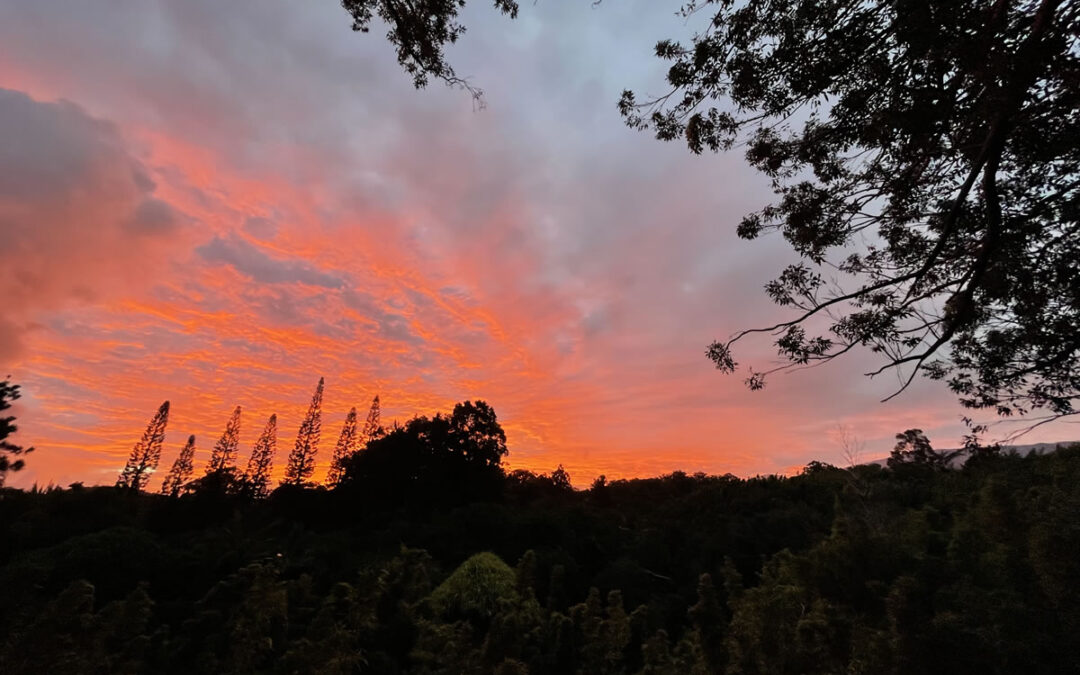ʻO nā kumumea ʻehā o ke ao nei, ʻo ia nō ka honua, ka wai, ke ea, a me ke ahi.
The elements of Nature are fourfold: Air (ke ea), Water (ka wai), Earth (ka honua) and Fire (ke ahi). The synergistic interplay of these four elements empowers the world to support life in all its forms. The wind raises the clouds to form the rain that nurtures the earth to grow vegetation, fruits and flowers and the wood that kindles the fire.
These foundational elements are mirrored microscopically in the human organism as well, enabling us to feel grounded and centered (Earth), mentally clear (Air), open-hearted (Water) and creative (Fire).
The islands of Hawaii Nei have been endowed with such a stunning natural beauty, a perfect symphony of raw elemental wonder, it is not surprising that Hawaiian culture and its beautiful language have woven these elements into a rich tapestry celebrating them in song and dance and story as well as in lifestyle and everyday conversation. It has also elevated them to the level of deity (na akua) for each of them carries the essential force (mana) that animates and perpetuates the continuum of Life.
Every one of the islands was born from the volcanic fires of Pele. The fresh waters of Kane flow abundantly to the sea where the blue waters of Kaneloa surround each island in all directions as far as the eye can see. On Maui, the windy moku of Hāmākualoa (Breath of God) lies on the fertile slopes of Haleakalā (House of the Sun). The air in the islands has been reported to be among the purest on earth, when the volcanoes are not venting, still engaged in the act of creation.
When we Nānā i ke kumu (Look to the source), it is with the soft eyes of the scout, the observer, penetrating the obfuscating fog of myopia. It is remembering the ancestors for their strength and wisdom and sense of place. This is true for kanaka maʻoli as well as kamaʻaina. It is consulting the star maps for the stories they tell. It is reading in nature the original teachings that are timeless. It is looking back in order to look forward. It is an act of love and respect that reveals the way.
When we do this, we are shown how critical it is that all beings “mālama honua”. It is this kuleana that each of us inherit by virtue of our birth. Translated as “to care for our island Earth”, the deeper meaning is to take care of and protect everything that makes up our world: land, oceans, living beings, cultures, languages and our ohanas. It means learning from the ancestors and kūpuna to take care of our limited resources as though we are living on an island in the middle of the ocean, as some of us are blessed to be.
It also means being in right relationship with the Four Elements that are the foundation of life on earth:
KE EA (Air)
It surrounds us and holds all life in its embrace. As a regulator of weather and climate, we call it Wind (makani). As a conveyor of life itself, we call it Breath or, in the Islands, Hā, which literally means “the breath of life”, indicative of how much mana is associated with Hā. The very essence of oneʻs soul is carried by the breath.
From the first Hā at birth to the final Hā at the crossing over, breath is consistent, involuntary and reliable (in a healthy mammal). You can bet your life on it. It is your constant companion. It holds a very sacred place in Hawaiian culture, ever-present. Whether it is paddling a wa’a (canoe) or dancing a hula or singing a chant or prayer, it is a deeply revered presence.
To say “aloha” to another person, for example, is to stand in the presence of the breath, spirit and light and to acknowledge and recognize all of this in the other. In effect, it means that a portion of my spirit will follow after you. Aloha! (I greet you with my breath.) Mahalo! (I thank you with my breath.)
KA WAI (Water)
The element of water, Ka Wai, is central to all life and this is particularly true on a volcanic island where water is often quite limited. It is so precious that the Hawaiian word for wealthy is “Waiwai”. This word also means “treasured” which is why it is used to described the core values treasured by Hawaiian culture, Na WaiWai.
KA HONUA (Earth)
The word honua means our planet Earth including its mountains and oceans. It is home to all the other elements and the web of life itself. It is the ground and the fundament upon which our world and everything in it depends.
KE AHI (Fire)
The transformative element of fire permeates Hawaiian mythology and culture. The fires of Pele fueled the very creation of the islands of Hawaii Nei but she also participates in their periodic transformation. The volcanic landscape is her handiwork. Personifying fire, one of her poetic names is Ka wahine ʻai honua (“the woman who devours the earth”).
The fiery star we call Ka Lā, the sun, also creates and destroys much like Pele. Named after the legendary Polynesian demigod who snared the sun to come to rest on top of its highest mountain, the island of Maui honors its distinguished place of residence with the name Haleakalā, House of the Sun. Māui is also credited with harnessing fire to make it more user-friendly.


Beloved Katya Ka Wai La’akea Streams
Your Bamboo Mountain Sanctuary website is deeply inspiring and very beautiful. Thank you for the resources and invitation to learn and contribute. Thank you for Mercy and your life work.